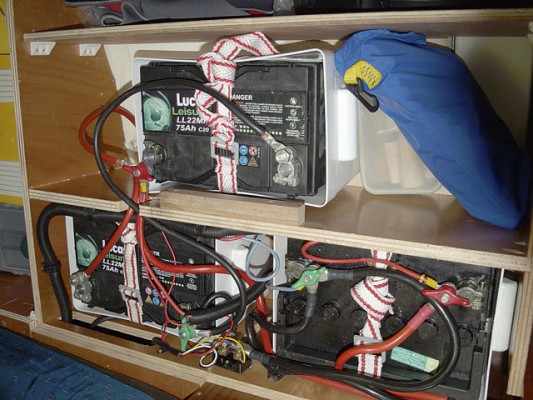Bob Goode boosts onboard power from a single to a double battery bank
When I bought her new, my boat had just a single 75Ah domestic battery, best described as adequate if you remained frugal with the amps. But having sunk the children’s inheritance into the hull and other essentials, there was nothing left over for the rather expensive second battery option.
When the first battery gave up after five years I replaced it with a 90Ah alternative that was slightly better. But six years later, when that was showing signs of fading, I decided to go all out and install a second battery, massively increasing the capacity and allowing greater independence from shore power.
I opted for a pair of 75Ah batteries giving a 60% increase in useable capacity over the 90Ah at minimal cost. When these eventually fail I intend to fit a pair of 90Ah batteries giving a further 17% increase – but this will need to be done in conjunction with an uprated battery charging system to get the best from it.
In the meantime, my existing 25A charging system has served me well and should continue to do so. When selecting a charger you’ll not go too far wrong with one rated in amps at around 25-30% of the battery bank capacity. My 25A charger is on the low side, then, but is adequate to recharge overnight what a long day takes out and so I opted to postpone this upgrade till another year.
How much space?
The first step was easy and dictated by the physical size of the spaces available, which in turn fixes the size of the battery to be added. I was fortunate in that I could construct a second battery compartment adjacent to the original and the existing live supply would be long enough
to reach to the new battery.
I used quite a bit of cardboard in making templates of the battery box floor and new side wall which would be up against the curvature of the hull and hence a compound shape. The new floor and side wall were cut from 12mm WBP plywood and then secured to existing furniture with cabinet corners. Into this I secured the new plastic battery box and retaining strap. That dealt with the easy bit.
Wiring up
Next step was wiring up the identical pair of new 75Ah batteries. It’s important they’re identical because if the batteries are unmatched, or one is older than the other, you could end up with the newer one discharging into the older one, shortening the life of both batteries. Another factor to take into account is that the circuit paths must be of equal length, more strictly equal resistance, for both batteries. If this isn’t the case then one battery
will always be carrying a greater discharge current than the other – again upsetting their longevity.
I achieved this by moving the positive lead onto the second battery and putting the negative lead on the first battery. Two identical-length flying leads were then crimped up to parallel the batteries. Again, a small but crucial point is to ensure that the same cross-sectional area of connecting wire is used as the original wiring (I found Halfords do ready-crimped battery leads in a variety of standard lengths).
There are some straightforward safety precautions to bear in mind when doing this work.
Lead-acid batteries are capable of delivering large currents if shorted out between the terminals, so make sure you keep the plastic terminal covers in place until you’re ready to make the connection to the terminal.
Be sure to disconnect from shore power so the battery charger is off before doing any work.
What battery capacity do you need for your boat?
The capacity of a battery is measured in amp hours (Ah). Simply put a 75Ah capacity battery can deliver 1A of current for 75 hours; 2A of current for 37.5 hours etc. In reality it is slightly more complicated than this as the available capacity reduces as the discharge current increases, and other factors will be at work.
In practice it is hard to get a battery charged to more than 80% of its maximum capacity with a standard, engine-mounted alternator or simple battery charger, although smart chargers and some after-market alternators can do quite a bit better than this.
It’s also not good for a battery to be taken down to less than 50% discharge as this causes damage to the plates within the battery, shortening its life. So the useable capacity is around 30% of the stated capacity, or 25Ah for a 75Ah battery.
Calculating current draw
To calculate the battery capacity you require you’ll need to know the current drawn by each appliance and for how long you intend to run it. For example: a 24W cabin light will draw 2A of current. If it’s run for three hours then you’ll need 6Ah of charge, requiring in turn an 18Ah capacity battery to support it. Work out what you expect to be running and for how long between charges and you can total up the battery capacity needed.
You may have gathered that the electrical needs on my boat are quite light – that’s because I’ve already changed my interior and the navigation lamps to LEDs with a significant saving in the need for juice.
Cost of the job:
2 x 75Ah batteries £110
2 x ready-made cables £11
1 x battery box £11
Plywood and fixings £20
Total £152




